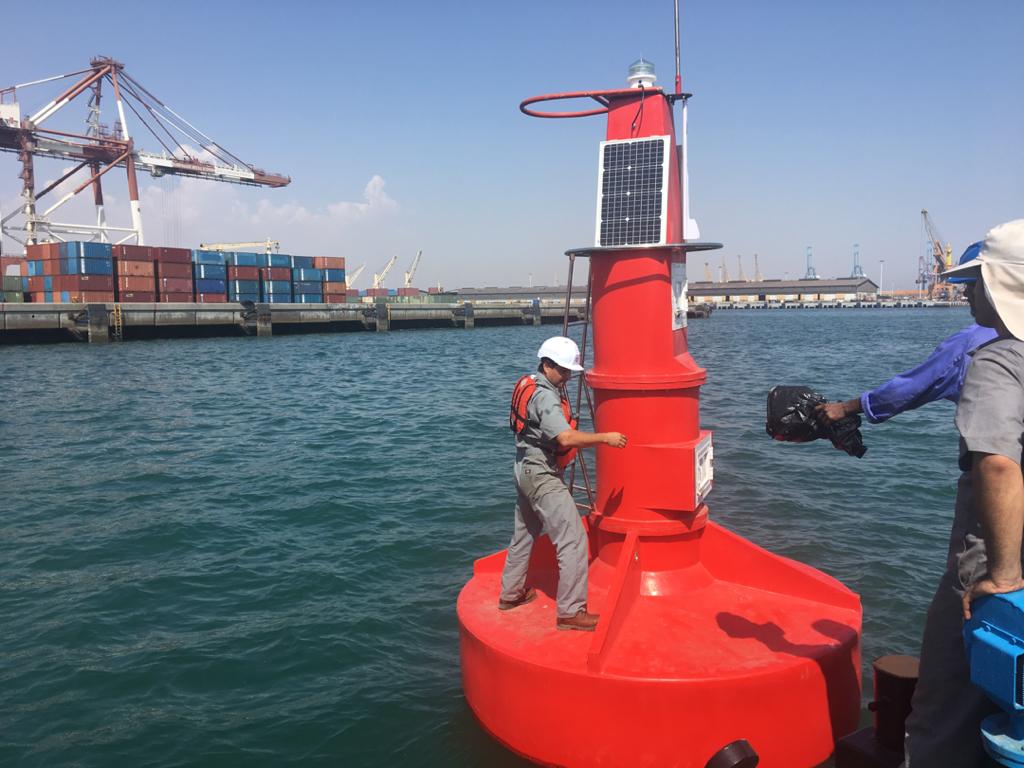
Navigational aid signs
Aids to navigation marks are any marks outside the vessel. These signs help navigators to determine the position and determine the safe route. Among the types of marine navigation aid signs, we can refer to lighthouses, sea buoys, warning sound signals, etc.
Buoys are one of the most important signs of navigation aid, which are established by chains and anchors in a specific position in the water. Buoys with the color and shape of the body during the day, and the warning light at night, enable the safe movement of vessels. For example, we can refer to the lateral buoys to mark the sides of the channels and the cardinal buoys to determine the safe traffic route. The color and shape of these buoys are determined by IALA, which is the regulatory body for aids to navigation.
History
Factors that jeopardize the safety of navigation in a waterway:
Improper depth of waterway
The presence of drowned bodies
Density of traditional and fishing vessels
weather conditions
Tidal factors
Geographical situation
The amount of traffic of reluctant ships, especially those carrying dangerous goods
At the end of the 19th century, in order to increase the efficiency and upgrade the navigation aid signal systems and research and development, in July 1957, the organizations responsible for lighthouses consisting of 20 countries agreed to establish a permanent organization for lighthouses.
In order to reach appropriate conditions, it is necessary to compile two systems as the first step. For example, red color was used to indicate the port side of the channels and another red color was used to mark the right side of the channels. These things caused the two systems to be separated. In this way, the system was called A and B. In 1957 AD (1336 AH), Iran was accepted as a member of the International Association of Lighthouses in the “A” buoyancy system group.
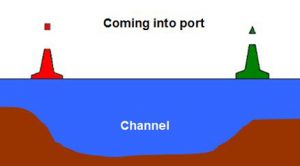
System B rules were completed by 1980. The rules of system B are used in the countries of North America, Central America, South America, Japan, Korea and the Philippines. The rules of system A are suitable for Asian countries and the waters of African countries. The rules in systems A and B were so similar that the committee The IALA executive combined these rules. After that, the two sets of rules were implemented in the form of a single set of rules.
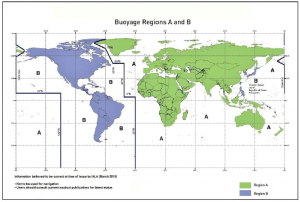
The most important changes in the 2010 revision are:
Incorporation of navigational aids for markings recommended by IALA, which includes emergency marking buoys, etc. Another change that was made was the integration of electronic signs through radio transmission with regard to aids to navigation.
General principles of the system
The responsibility of safe navigation is the use of appropriate navigational aids, including official maritime and navigational documents. This system has two components: 1- Marine buoys 2- Other aids given to the navigator by means of fixed and floating devices. There are 6 types of signs in the system of marine vessels that may be used alone or in combination. These side signs are different between A and B areas.
These symptoms are described below:
Side symptoms
A modified lateral sign may be used at a point in the channel for preferential division. This sign is different for zones A and B. For example, in zone A, red and green colors indicate the port side and the right side of the channel during the day and night. In area B, the red color refers to the column and the green color refers to the port.
Cardinal signs
Cardinal marks indicate that the deepest water in the area is on the named side. For example, if a mark is north, it refers not only to north, but also to water moving north. Cardinal marks also have a flashing system. are special The rhythm of lights is basically very fast or fast. So 100 or 120 blinks per minute means very fast blinking and 50 or 60 blinks per minute means fast.
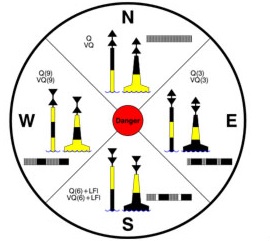
Range
Nautical systems and other aids to navigation provide rules. In order for these signs to be consistent for everyone, signs including floating signs, electronic signs, etc.
Types of signs
Cardinal signs with a compass to show where the mariner may find navigable water.
Isolated danger signs to indicate hazards of limited size that can be controlled
Marking safe and navigable waters around it
Special marks to indicate a special area in maritime documents
Other signs used to provide information to aid navigation
The method of determining the signs, the importance of the signs depends on one or more of the following features:
At night, the color and rhythm of light
On the day of the color and shape of the marking above
Digital symbology as a complement to the physical signs of electronic symbology
Electronic symbology

Signs on the right and left side of the channel



Isolated danger sign
This marine buoy sign means that there is a danger around that water for shipping. For example, it refers to a shallow point or a sunken vessel. On the other hand, due to the degree of danger and the exact safe distance, it cannot be passed for all conditions that It is better for the mariner to avoid approaching that point and maintain a safe distance from either side of the mark.
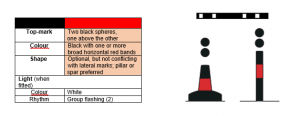
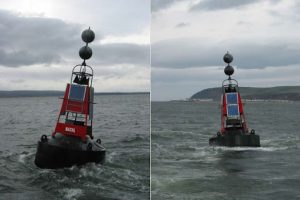
Safe water sign
The sign of safe waters means movable waters around it. This sign indicates that there is no danger in the freeways, the middle channel, etc. For example, the anchorages near each port indicate that the passage of the vessel around the safe waters sign is unimpeded. Is.
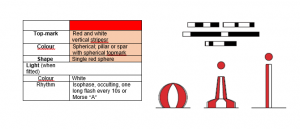
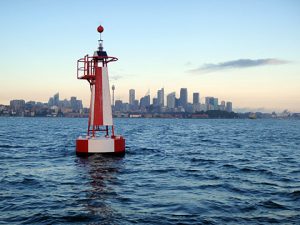
Special signs
Special marking buoys are used to indicate a specific area. Or the feature is revealed from that area, which is mainly for marking channels or blockages in MBS cases. The presence of this sign means that the vessel is not allowed to sail in that area. For example, an area of the sea that is intended for military maneuvers. Taken.
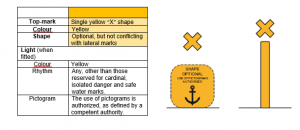
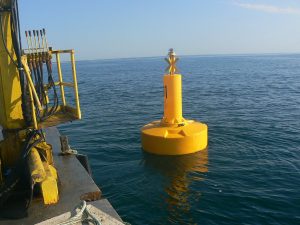
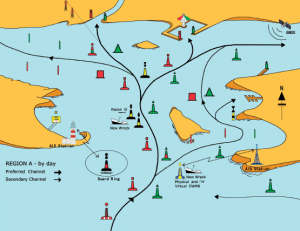
In the design of the marine buoy and the selection of the most suitable buoy in the areas of use, special attention should be paid to the following points and items:
Average water depth
The speed of water flow during high and low tides
Average wind speed
The size of the wave height
Volumetric mass of water
The distance between the buoy point and the surrounding land
Buoys are divided into the following two categories according to the body type:
Metal body buoys
Non-metallic buoys
Metal buoys
Buoys with a metal body have problems and disadvantages, which can be briefly divided into the following two categories:
۱٫ Disadvantages caused by problems and problems during the construction of buoys:
The problem of transportation of metal body buoys is because they are integrated
– The weight of the anchor and its supporting chain and related accessories
– The need for special protective coatings and paints against sea water
۲٫ Disadvantages caused by problems and problems during the operation of the buoy:
The need for frequent inspections to control the appearance of the body color and the appearance of the buoy
– The possibility of drowning the buoy due to a hole in the body and water entering it
– The impossibility of repairing metal buoys in their position in the sea and the need to send them to shore and land
– The impossibility of using small vessels to transport metal buoys to land due to their heavy weight
Fiberglass buoys
Fragility due to impact
Lack of color stabilization due to environmental conditions
Polyethylene buoys
Buoys with polyethylene body have merits and advantages, which briefly include:
Light weight of polyethylene buoys compared to metal buoys in comparison with the same application
Greater resistance to salt water and, as a result, longer life
Homogeneity of polyethylene buoys and complete symmetry in their geometry compared to metal buoys
Reducing the weight of cast iron anchors and weights due to their lighter weight than metal buoys
The non-sinking of this type of buoy due to the lack of water penetration into them due to the presence of foam inside the buoys
Reduction of periodic inspections due to their greater resistance
Less deformation due to external shocks due to the presence of foam inside them and as a result, they are more susceptible to impact than metal buoys.
Polyethylene buoys do not need to be painted. Because it is produced using colored pigments that penetrate through plastic.
Ability to move with small floats due to their light weight
Unlike metal buoys, it does not need to be transferred to dry land and sandblasting, pitting, repainting in three layers. All maintenance operations can be done at sea and on a small vessel
This means that a smaller float and less personnel are needed to install and remove the buoy from the water. As a result, the cost will be significantly reduced.
In case of transfer to land for repairs, the repair operation is much easier than metal buoys. Only minor repairs are done on the plastic body
Polyethylene buoys can be produced in different sizes from 600 mm to more than 3000 mm.
Polyethylene is recyclable and compatible with the environment.


